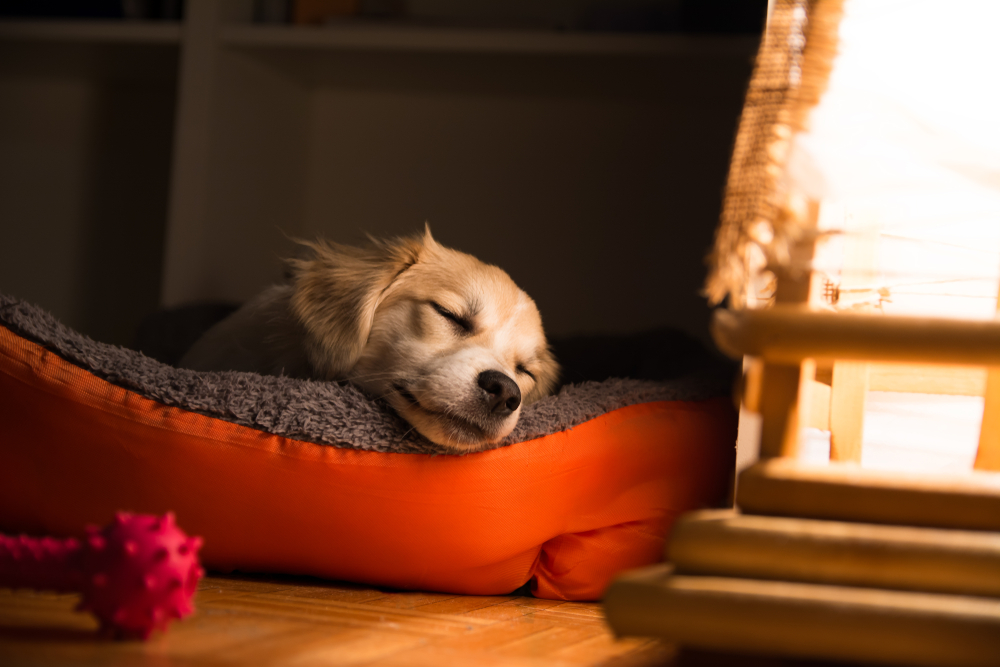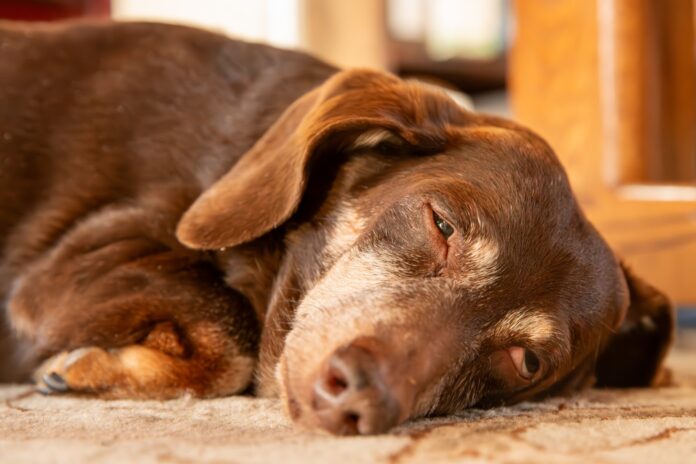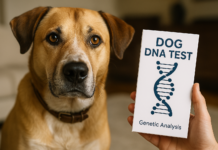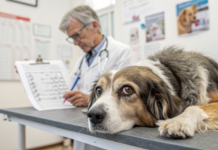Last Updated on August 7, 2024 by Dogs Vets
Sleep apnea is a condition where breathing intermittently stops and restarts during sleep. While this serious disorder affects about 10% to 30% of adults, can our canine companions also suffer from it?
Yes, dogs can indeed experience sleep apnea. Although sleep disorders are uncommon in dogs, sleep apnea is one of the main issues veterinarians address.
This article provides crucial information about sleep apnea in dogs and what you should know if you suspect your pet has it.
What is Sleep Apnea in Dogs?
Sleep apnea in dogs mainly involves obstructive sleep apnea (OSA).
Unlike central sleep apnea, which is less commonly observed in dogs, OSA occurs when a dog’s airway becomes blocked or constricted during sleep, preventing air from reaching the lungs.
This blockage can cause repeated interruptions in breathing throughout the night.

Common Signs of Sleep Apnea in Dogs
Recognizing sleep apnea in dogs can be challenging. Key signs to watch for include:
- Choking
- Coughing
- Snoring
- Excessive tiredness
- Gasping for air
- Noisy breathing
- Interrupted sleep
- Breathing pauses
- Cyanotic (blue-tinged) gums

Causes of Sleep Apnea in Dogs
Several factors can contribute to sleep apnea in dogs, including:
Brachycephalic Breeds:
Sleep apnea is frequently seen in brachycephalic breeds like English Bulldogs, Pugs, and Boston Terriers. These dogs have shorter skulls, leading to compressed airways and breathing difficulties. Their internal nasal structures are often malformed, exacerbating the issue.
Obesity:
Overweight dogs are at a higher risk for sleep apnea. Excess fat can put pressure on their airways, making it harder to breathe both during the day and night.
Obstructions:
Dogs can develop polyps or tumors in their nasal passages or throat, leading to obstructions that hinder airflow.
Allergies:
Allergic reactions that inflame the nasal passages can also cause sleep-disordered breathing.
How Sleep Apnea Affects Dogs
Sleep apnea negatively impacts dogs similarly to humans.
Dogs typically require around 11 hours of sleep daily, crucial for brain function, memory, immune health, and learning.
Sleep deprivation can lead to infections, irritability, and overall poor health.
Treatment Options for Sleep Apnea in Dogs
Treating sleep apnea in dogs can be complex. While humans often use a CPAP machine for OSA, no such device is currently approved for dogs.
Treatment options for canine sleep apnea include:
- Lifestyle Changes: If obesity is a factor, a reduced-calorie diet and increased exercise can help.
- Medication: Drugs like ondansetron may alleviate sleep-disordered breathing in some dogs.
- Surgery: In severe cases, surgical intervention may be needed to address anatomical issues.

Does My Dog Have Sleep Apnea if They Snore?
Snoring alone does not necessarily indicate sleep apnea. It can result from similar factors, such as airway structure, allergies, or obesity.
If snoring is a new symptom, consult your vet to rule out more serious conditions.
Final Thoughts
Although sleep apnea in dogs is rare, it can significantly impact their health. Brachycephalic breeds are most commonly affected.
If you notice symptoms of sleep apnea in your dog, consult your veterinarian for a comprehensive evaluation and appropriate treatment plan.
FAQS
Can sleep apnea in dogs be cured?
Yes, sleep apnea in dogs can be managed and potentially cured depending on the underlying cause. For example, lifestyle changes, such as weight reduction and increased exercise, can help if obesity is a factor. In some cases, surgery may be required to correct anatomical issues. Your veterinarian will recommend the best treatment plan based on your dog’s specific condition.
How can I tell if my dog has sleep apnea?
Look for signs such as snoring, choking, coughing, excessive tiredness, and gasping for air during sleep. Additionally, if you notice your dog’s breathing pauses or if their gums appear bluish (cyanosis), these could be indicators of sleep apnea. A visit to the vet is essential for a proper diagnosis and to rule out other potential issues.
Are certain dog breeds more prone to sleep apnea?
Yes, brachycephalic breeds are more prone to sleep apnea due to their anatomical structure. Breeds like English Bulldogs, Pugs, Boxers, and Boston Terriers often have shorter skulls and compressed airways, which can lead to obstructive sleep apnea.
Can sleep apnea in dogs cause long-term health problems?
Yes, if left untreated, sleep apnea can lead to various health issues in dogs, including decreased immune function, increased risk of infections, and behavioral changes. Ensuring your dog receives appropriate treatment is crucial for their overall well-being and quality of life.
What should I do if my dog is snoring?
While snoring alone doesn’t necessarily indicate sleep apnea, it’s important to monitor any changes in your dog’s sleep patterns. If snoring is new or accompanied by other symptoms like choking, gasping, or excessive tiredness, consult your veterinarian. They can assess your dog’s condition and provide guidance on whether further evaluation or treatment is needed.

















